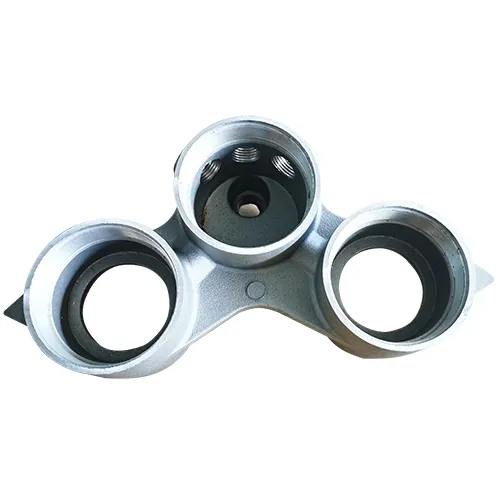Mobile:+86-311-808-126-83
Email:info@ydcastings.com
Understanding the Use of Copper Pipe End Caps in Plumbing Applications
The Importance of Copper Pipe End Caps in Plumbing
Copper pipe end caps are essential components in plumbing and HVAC (heating, ventilation, and air conditioning) systems. They serve a crucial role in ensuring the integrity and efficiency of fluid transport systems. Understanding these components—from their materials to their applications—can help homeowners and professionals make informed choices in their projects.
What Are Copper Pipe End Caps?
Copper pipe end caps are fittings designed to seal the end of a copper pipe. They ensure that no fluid escapes from the pipe ends, which helps to maintain pressure and prevent leaks. Typically, these caps are made from high-quality copper, known for its durability, resistance to corrosion, and excellent thermal conductivity. The manufacturing process ensures that they can withstand various temperatures and pressures commonly experienced in plumbing systems.
These end caps can be found in various sizes, accommodating different diameters of copper pipes. The majority of them are joined using soldering techniques, but they can also connect through alternative methods such as crimping or threading, depending on the application.
Types of Copper Pipe End Caps
There are primarily two types of copper pipe end caps solder type and compression type.
1. Solder Type Caps These are the most common and are permanently fixed with solder, creating a watertight seal. To install a solder-cap, one must heat the cap and pipe joint, applying solder to fill the joint and create a secure bond.
2. Compression Type Caps These caps provide a quick and easy installation process. They utilize a compression ring and nut that tightens around the pipe. These can be unscrewed for maintenance or modifications, making them an excellent choice for projects requiring flexibility.
Applications of Copper Pipe End Caps
Copper pipe end caps are utilized in several applications
- Residential Plumbing They are extensively used in home plumbing systems to cap off unused pipe ends. This is especially important during renovations or repairs, where certain sections of plumbing may become obsolete.
- HVAC Systems In HVAC applications, copper pipe end caps are crucial in sealing the ends of refrigerant lines. This preservation of refrigerant is critical for the system's efficiency and longevity.
- Industrial Uses In various industries, copper end caps are used in systems requiring a sterile and corrosion-resistant environment. They are commonly found in food processing and pharmaceutical applications.
copper pipe end cap

Benefits of Using Copper Pipe End Caps
Using copper pipe end caps offers several advantages
- Corrosion Resistance Copper is naturally resistant to corrosion, making it an ideal material to prevent contamination of fluids transported through the pipes.
- Longevity Properly installed copper pipe fittings last for decades, reducing the need for frequent replacements, which can save costs in the long run.
- Sustainable Material Copper is a recyclable material, making it an environmentally friendly choice for plumbing applications.
- Thermal Conductivity Copper's excellent thermal conductivity is advantageous in systems that involve heating or cooling processes, as it allows for efficient heat transfer.
Installation Tips
When installing copper pipe end caps, it is essential to follow some guidelines to ensure a proper seal
1. Clean the Pipe Ends Before attaching the cap, clean the pipe ends to remove any dirt, grease, or oxidation that may interfere with the sealing process.
2. Heat Evenly If using solder caps, apply heat evenly around the joint to avoid overheating certain areas, which can lead to weak seals.
3. Proper Soldering Technique Use the correct type and amount of solder, and allow it to flow into the joint completely for a strong bond.
4. Testing for Leaks After installation, it’s crucial to pressurize the system and check for leaks. Any signs of dripping or moisture should be addressed immediately.
Conclusion
Copper pipe end caps are invaluable in plumbing and HVAC systems, providing essential sealing functions that ensure the effectiveness and durability of these systems. By understanding their types, applications, and installation techniques, plumbers and DIY enthusiasts can leverage these components to enhance their projects while maintaining safety and efficiency. Investing in high-quality copper fittings not only supports system integrity but also contributes to a sustainable and long-lasting plumbing infrastructure.
-
Why Should You Invest in Superior Pump Castings for Your Equipment?NewsJun.09,2025
-
Unlock Performance Potential with Stainless Impellers and Aluminum End CapsNewsJun.09,2025
-
Revolutionize Your Machinery with Superior Cast Iron and Aluminum ComponentsNewsJun.09,2025
-
Revolutionize Fluid Dynamics with Premium Pump ComponentsNewsJun.09,2025
-
Optimizing Industrial Systems with Essential Valve ComponentsNewsJun.09,2025
-
Elevate Grid Efficiency with High-Precision Power CastingsNewsJun.09,2025











